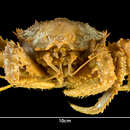en
names in breadcrumbs


"Material examined
Moscow University Zoological Museum
1 ♂ holotype, 1 ♀ ov.., allotype, 2 ♀, paratypes,
R/S Ebrika, St. 90, 26 March 1972, 46°01.5' S, 60° 40.3' W, 132 - 135 m
Description
Carapace rounded, more or less pentagonal, covered with numerous, more or less pointed granules. Some small but conspicuous spines near the anterior edge of the carapace, present on all the specimens. Gastric region somewhat more prominent than the other regions, with a granule thicker than the rest (a small spine in smaller individuals) in the centre of the region. Branchial regions slightly convex, somewhat more prominent than the cardiac region. A thick, spiniform granule in the middle of each of the branchial regions, more acute in juveniles. Two thick, spiniform granules similar to these near the posterior carapace edge. A small spine on the terminal angle of the pterygostomian region.
Basal spine of rostrum slightly curved, ventral surface smooth. Two slightly divergent, upward-slanting, dorsal spines. Two small spines at the base of each of the dorsal spines. Basal spine and the two dorsal spines all overreaching the corneas. External orbital spine somewhat shorter than the eyestalks, as long as or somewhat longer than the anterolateral spine. Numerous spines on the lateral carapace edge, forming an outward-projecting crest, the spines thicker and more developed on the anterior half of the carapace, becoming smaller granules on the posterior half.
A few small granules on the abdomen. Marginal and lateral plates on third segments separate from the lateral plates, subdivided in the female but no in the males.
Basal segment of antennal peduncle with a small antero-external spine. A long antero-external spine on the second segment, overreaching the base of the last article of the antennal peduncle, with one-two spines at the base. Scaphocerite with a long, central spine extending slightly beyond the tip of the last segment of the antennal peduncle. Two long spines and one small spine on the outer border, and one-two spines on the inner border. Some granules dorsally.
Chelipeds with merus bearing thick spines on the terminal border. Carpus with thick spines on the dorsal border and other, smaller spines on the outer, and ventral surfaces. Spines on the dorsal border of the hand. Some smaller spines on the outer and, ventral surfaces. Numerous tufts of setae on fingers.
Third walking leg less than twice carapace length in the female and a little more than twice carapace length in the males. Some spines on the terminal border of the basis-ischium. Merus shorter than carapace length, between 3.5 and 4.5 times longer than high, and almost twice carpus length, with a row of eight-ten well-developed spines on the anterior margin that do not form a crest. Various spines on the posterior border and dorsal surface not in well-defined rows. Carpus with a row of four-five spines on the anterior margin, with two-three smaller spines interspersed. Some scattered spines dorsally. Propodus somewhat shorter than the merus and as long as the dactylus, anterior margin with 10-12 spines that do not form a row. Some smaller spines on the posterior margin. Dorsal surface practically smooth. Ventral surfaces of all articles smooth. Dactylus slightly curved, with four spines at the base of the anterior border and a single spine at the base of the dorsal and ventral surfaces. A row of nine-ten corneous spinelets on the posterior border. Some scattered tufts of setae, mainly on the anterior border.
Tips of most of the spines on the chelipeds and walking legs on the holotype bearing tufts of more or less long setae. Such tufts of setae are less abundant and smaller in the rest of the specimens examined.
Size
Carapace length is 97 mm, carapace width 102 mm, in the holotype. Length and width are both 68 mm in the allotype. The two paratypes are the same size, 82 mm long and 85 mm wide.
Distribution
Continental shelf off Argentina, north of the Falkland Islands (Malvinas), between 132 and 135 m in depth.
Remarks
Paralomis anamerae is closely related to P. africana Macpherson, from off Namibia (p. 110), but it is differentiated by a number of characters:
- More granules but no spinules on the dorsal carapace surface in P. africana (Plates 26B, 27).
- Two pairs of small spines on the base of the rostrum in P. anamerae, sometimes one pair in P. africana (Figures 51A, B, G, 52A).
- Three-four spines on the inner border of the scaphocerite in P. africana, one-two in the new species (Figures 51C, 53A).
- In P. anamerae, thick spines on the articles of the walking legs, no crest on the merus (Figure 53D). In P. africana spines smaller but forming a small crest on the merus (Figure 511).
- Walking legs longer and more slender in the new species.
Etymology
This species is dedicated to the Asociación Nacional de Armadores de Buques Congeladores de Pesca de Merluza (ANAMER) (National Association of Owners of Freezer Trawlers Engaging in the Hake Fishery), in recognition of its valuable support and collaboration in the research work undertaken by our Institute."
(Macpherson, 1988)